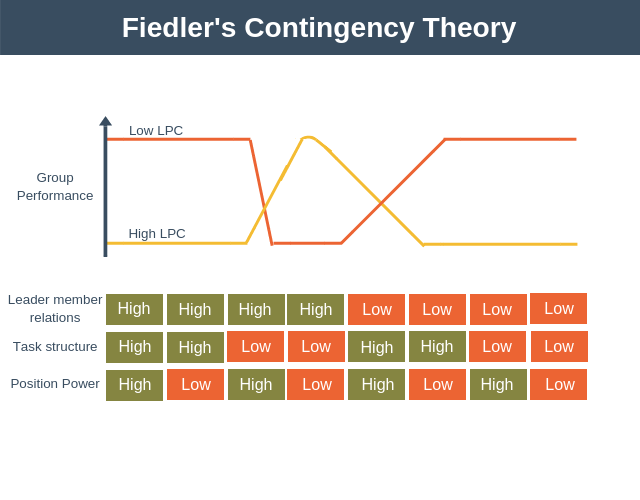Disclaimer: We sometimes use affiliate links in our content. For more information, visit our Disclaimer Page.
John F. Kennedy once said, “The most important thing in life is to never give up.”
This is a sentiment that rings true with contingency theory. The theory posits that success is not a matter of luck but rather the result of hard work and planning. According to contingency theory, success depends on an individual’s ability to identify opportunities and capitalize on them.
Successful people have contingency plans for when things don’t go their way. If you’re looking to achieve your goals, it’s essential to understand how contingency theory works and put its principles into practice.
In business, there is always a chance that something could go wrong. This is why contingency theory is so critical- it helps companies plan for the unexpected. This post will explore what contingency theory is and how businesses can use it to their advantage. Stay tuned!
Who is Fred Fiedler?

Dr. Fred Fiedler was born in Wisconsin in 1928 and received his bachelor’s degree from Beloit College in 1950, where he majored in economics with a specialty in government and international relations. He received his master’s degrees in industrial management from the University of Michigan and psychology from California State University, Los Angeles.
His Ph.D. is in industrial psychology from the University of Southern California, where he also did postdoctoral work in physiology at USC Medical School with a specialty in stress research. He pioneered research on contingency approaches to management that have had a worldwide impact.
What is the contingency theory of leadership?
The contingency theory of leadership was developed by Fred Fiedler in the 1960s and is concerned with leadership effectiveness in various circumstances. The theory focuses on assessing an individual’s behavior based on their effect on followers and groups, rather than role descriptions such as charisma or intelligence.

According to contingency theory, a leader’s performance is dependent on whether their leadership style is appropriate for the situation. According to this idea, a person can be a successful leader in one setting and an ineffective leader.
The theory proposes that groups with low levels of anxiety function best under autocratic leadership structures, while those with high anxiety benefit from democratic styles. Research supports this because subordinates are more likely to accept decisions made by an autocratic leader or a democratic leader if there is a relationship between the two.
Group size, task structure, and outcome favorableness also affect leadership style. For example, Fiedler found that groups with large memberships were more likely to function best under democratic rather than autocratic leaders if psychological bonds existed between them. Moreover, he claimed that a democratic leader could lead them if their task structure is simple and clearly defined.
Finally, Fiedler’s contingency theory suggests that a person’s leadership style changes depending on the situation. In this respect, it differs from trait-based leadership theories because it does not argue that traits determine an individual’s effectiveness as a leader.
Related: 16 Leadership Styles
What is the contingency approach theory?
Contingency approaches to management theory hold that a manager’s effectiveness is contingent or dependent upon the interplay between their behavior and specific situations. In other words, the way you manage should change depending on the circumstances–one size does not fit all.
The contingency approach draws its name from its emphasis on “contingencies,” or situational factors that contribute to effectiveness. A contingency approach to management is more flexible than other approaches because it allows managers to adapt their behavior according to varying circumstances.
The circumstances that affect the manager’s job performance include many variables, some of which are outlined below. These contingencies serve as guidelines for how managers can succeed in various situations. The more aware managers are of the contingencies that affect their job performance, the more effective they will be.
1) Type of task
2) Organizational structure
3) Personal characteristics of employees
4) Authority level of managers involved in an interaction
5) Formal organizational rules and procedures
6) Leader-member relations
Research indicates that the contingency approach to management is valid in various settings. For example, when studying the effectiveness of supervisors, researchers found that interpersonal support from higher-level managers can help employees feel more positively about their work and enhance overall performance.
In another study, workers supervised by a supportive and empathetic manager increased productivity. One-size-fits-all policies and procedures do not work in all circumstances. In some cases, the contingency approach to management theory offers a more effective way for managers to help employees thrive.
Thus, a manager’s effectiveness is contingent or dependent upon the interplay between their behavior and specific situations.
Examples of Contingency Theory
The two examples of Contingency Theory are given below.
The first example of contingency theory is modularity
In this type, organizations have many different departments with separate functions, such as sales and marketing. As a result, the program requires little coordination between the two departments.
This means that project planning is not necessary to coordinate the work of these departments. However, if there were a need for much interaction or communication between different teams, then it would be coordinated by a project manager to ensure that all requirements are met, and deadlines are achieved.
The second example of contingency theory is bureaucracy
This term describes formality and hierarchy in the organization’s process, and decision-making Formalization entails systematically hiring employees into a firm, job descriptions, and evaluation systems.
Hierarchy entails a single person or a small group of people in charge of the organization. The role of contingency theory here is to develop an ideal type for how formalization and hierarchy complement each other if they are both present in an organization.
Main variables of Fiedler’s Contingency Theory
Fiedler’s Contingency Theory of leadership has three main contingency variables: Leadership Style (also called ‘Task Structure’), Leader-Member Exchange (LMX), and Position Power.
1. Leadership Style
The first variable, Leadership Style, is how a leader behaves toward subordinates under specific situational conditions. The situation can be divided into two types: Task Structure or Relationship Context. Here are three different leadership styles proposed by Fiedler’s Contingency Theory of Leadership.
- Leadership By Consideration
- Leadership By Coercion
- Autocratic Leadership
2. Leader-Member Exchange (LMX)
The second variable, Leader-Member Exchange (LMX), deals with trust, liking, or disliking, an individual characteristic that affects how leaders interact with their subordinates. The theory states that when there is little difference between leaders’ personalities and subordinates’, they will most likely have an excellent relationship.
In other words, when the leader is easy-going and friendly while subordinates are mature and goal-oriented, LMX or Leader’s Personality positively impacts their Leadership Style towards the company they manage.
3. Position Power
The third variable, Position Power (or strong leader position power. ), deals with how much power leaders have under high task structured situation in organizations where close supervision from above are necessary because of highly decentralized authority or limited span of control.
It measures a leader’s ability to get things done in the organization. Here again, there are three different types: Personal Influence, which reflects a leader’s inherent leadership qualities; Coercive Power, which reflects a leader’s ability to punish followers by withholding rewards or promises of future reward; and Legitimate Power which is a result of the leader occupying certain official positions in an organization. In other words, leaders have authority from their respective organizations to perform tasks using any of these three forms of power.
What are the 4 contingency leadership theories?
Contingency leadership models are theories under the general umbrella of contingency theory. Contingency leadership models differ from other theories because they focus primarily on the leader’s leadership style rather than on whether the leader is more effective than others.
The four most recognized contingency theories are the Fiedler Contingency Model, the Situational Leadership Theory, the Path-Goal Theory, and the Decision-Making Theory. Of these four models, Fiedler is by far the most well-known.
1. The Fiedler Contingency Model
The Fiedler model suggests that if a leader is high in their position of power (distinct from personal power) and their task structure (ability to organize work), they will use task-oriented leadership behaviors regardless of whether their follower has an internal or external orientation.
If they are low on both of these qualities, they will use relationship-oriented leadership behaviors with either type of follower; however, if they are high in position power and low in task structure, they will use relationship-oriented leader behaviors with an external follower and task-oriented behavior with an internal follower.
The Fiedler model was based on the idea that a leader’s position power is dictated by the authority of their position and can change during times of stress. In contrast, personal power is derived from individual qualities like charisma or expertise.
2. The Situational Leadership Theory
According to this theory, there is no such thing as a universally “good” style; instead, good leadership comes down to matching your leadership style to your followers’ needs at a given time. This means that you can’t successfully run every project the same way—even if you’ve had success doing it one particular way in the past.
The theory is based on the idea that people have different readiness to take on a task—some are more motivated by concern for their competence, some by learning new skills, and others by developing intimacy with coworkers. In short, you need to be flexible in how you approach your leadership style.
3. The Path-Goal Theory
The path-goal model focuses on the relationship between leader behavior and follower satisfaction in a given context. The theory suggests a matching process between an individual’s motivation and commitment to a specific task and the path taken toward completing that task [if it can’t be achieved, they won’t).
It uses three dimensions of leadership: consideration (how much effort does the leader put into establishing two-way communication), initiating structure (how much does the leader define what needs to be done), and consideration (the extent to which the leader encourages participation in decision making).
4. The Decision-Making Theory
According to this theory, the decision-making style is vital for a leader’s effectiveness because individuals are more motivated when they have some input into decisions. The four styles are directive (makes the decision alone based on facts only), consultative (discusses the problem with subordinates but makes final decision alone), group participative (meets with subordinates who make recommendations, but makes final decision alone), and group-democratic (allows group discussion then provides everyone in the group to vote on final solution).
Final Thoughts
It’s never too late to start planning for success. But, if you’re looking to increase your odds of achieving a successful outcome in any endeavor, then it might be time to take the first step towards that goal–start with contingency theory.
Understanding how this theory can help create more positive outcomes will allow you to identify opportunities and capitalize on them as they arise.





